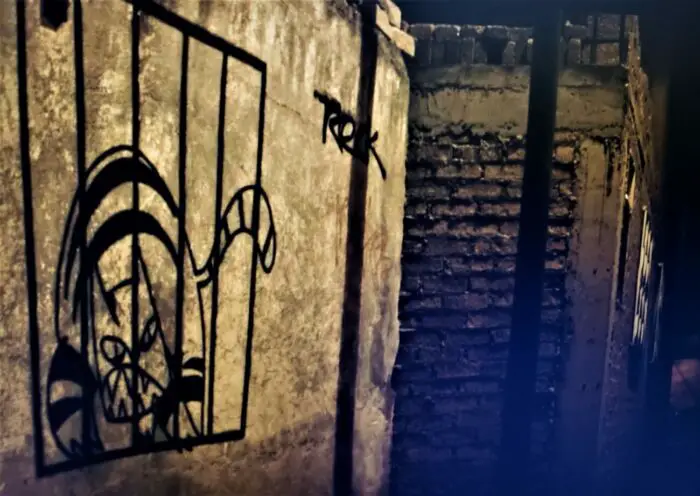Editor’s note: All throughout October, the vibes get spookier and the nights get longer. It’s the perfect time of year to watch horror movies, whether you’re a year-round horror fan or you just like to watch horror flicks to get into the Halloween spirit. This year at Horror Obsessive, for our 31 Horror Classics Revisited series, we’re giving you one recommendation for a classic horror film each day throughout the month of October. What do you think–is this film a horror classic? What other horror films do you consider to be classics, and what films do you make sure you watch each October? Let us know in the comments below.
Once upon a time, the dark fairytale Tigers Are Not Afraid crept out of Mexico, hunting wider and wider two years after its release. Along the way, this fey yet grittily grounded horror story quietly murdered audiences. Writer-director Issa López mixed genuine emotion with shockingly sudden irrevocable tragedy into an eviscerating combination. The film eventually caught the attention of horror titan Stephen King, who along with the likes of Neil Gaiman and Guillermo del Toro, championed the film. Now, Tigers are Not Afraid is lurking on several streaming services, ready to ravage whatever viewer ventures its way.
Make no mistake, this is a different breed of horror. Those seeking a slaughter smorgasbord may find themselves disappointed at the virtually bloodless story. Yet, Issa López’s film is no less unsettling than any blood-soaked grand guignol. That’s because Tigers Are Not Afraid uses every jagged facet of humanity, juxtaposing heartwarming elements against chilling true-life terror. It’s a recipe for frights that feel real because they are, instilling authentic dread in those watching the characters endure them.

Popcorn-munching spectators settled in for silver screen slaughter can usually smirk their way through the predictable rollercoaster of most movie massacres. However, Tigers Are Not Afraid rips open a watcher by forging a connection with its characters. Then, when death takes someone, it’s not only grim but a tragedy felt by all including the audience.
The story takes place in what is essentially a Mexican ghost town. Every day someone vanishes or dies due to cartel violence, and many of those left alive have fled the city if they can. As is made clear at the film’s opening, this is an all too true reality in Mexico. Tigers Are Not Afraid then follows a group of children, orphaned by this ongoing nightmare. The film’s main focus is on Estrella and Shine, played by Paolo Lara and Juan Ramón López.
Fantastical elements intermingle with urban realism creating cutting edges. While there are ghosts, the source of the specters is far more sinister than any spook. At times fantasy seemingly makes room for escapism, but certain grim realities make true-life horror unavoidable. At the risk of spoilers, an adorable plush toy may come to life, but it is still stained with the blood of its owner, who died clutching the doll. Furthermore, Estrella is given the gift of three wishes. Unfortunately, using them never brings the outcome she desires, nor changes reality much for the better. Again, risking spoilers, she cannot wish her lost mother back, only the ghost can return. Regardless of any magical realism, death remains irrevocable.

Part of what lures a viewer into the jaws of Tigers Are Not Afraid is the film’s visuals. Issa López and cinematographer Juan Jose Saravia have crafted dreamlike views on the edge of the unreal. Yet, they remain grounded enough to seem plausible. Though this urban fairytale ventures down a rabbit hole, it never enters any realm unfamiliar.
In addition, the movie manages several cinematic tricks which affect an audience even without their knowledge. The camera is often at eye level with the children creating the sense of being one of them. The audience may as well be a mute member of the kids’ gang. Whenever something supernatural, particularly anything sinister, occurs on screen, the view is often avoiding that horror. For instance, a ghost is never seen straight on as if the audience is a terrified child trying not to look at it.
Never quite seeing the supernatural also adds a blank canvas for audiences’ imaginations to fill. Sometimes those horrors hit hardest. Worse, though one could also say best, Tigers Are Not Afraid forges a connection with its characters.

Watching the young children in this corroded metropolitan neverland, somehow still possessing a spark of innocence despite the hurricane of horrors howling around them, it takes a truly heartless person not to care about them. In so caring, threads wind a noose around the unsuspecting viewer. And at the right moment, Issa López sends spectators down through the gallows drop.
I personally found myself caught off guard not only by certain deaths but by the emotional impact of each. It made me genuinely sad to see one character die. Plus, the very real sense that loss will haunt the characters forever after made for a kind of horror that unsettles more than any slasher kill can.
At Tiff Talks, Issa López mentioned how casting saw about 600 children. Ultimately, they settled on performers without acting experience. It’s always a gamble chancing an untrained individual, hoping they bring a certain authenticity to a role. However, taking that risk rewarded Tigers Are Not Afraid with genuine performances by all the children. They then cease to be merely characters on screen and carry a sense of being real people furthering feelings for them.

This turns the surrounding suspense of their situation into something with more sizzle than a Saw movie. In that franchise, almost every character is merely splatter fodder for the latest Rube Goldberg gore machine. The audience is basically watching, waiting to see disposable people die. In Tigers Are Not Afraid, Issa López fearlessly goes in a more sentimental direction. By creating this connection with the characters, everything bad which happens to them cuts deeper. The film proves a dozen gory kills are nothing compared to one devastating death.
By the time the end arrives, the audience wants the kids to escape their hideous circumstances. Although, as is often the case, in this film and in real life, happily ever after isn’t easy, if even possible. Still, it’s refreshing to see modern horror striving to conjure a desire for optimistic outcomes over the pessimistic acceptance of grim conclusions. Perhaps that’s why Tigers Are Not Afraid is considered a fairytale. If nothing else, that leaves room for the unreal, such as the possibility nothing bad happened. It was all just a story, and the desire for that to be true, to avoid reality, is part of the horror here as well.



